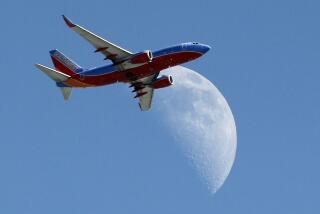Fatigue cracks found in Southwest plane
- Share via
The National Transportation Safety Board will consider whether to upgrade inspection criteria on Southwest Airlines Boeing 737-300s and other aircraft after finding evidence of fatigue fractures in the torn section of a Sacramento-bound plane that depressurized and made an emergency landing, authorities said Sunday.
Flight 812 was about 18 minutes into its flight out of Phoenix on Friday when a small section of the fuselage skin burst open, terrifying the 118 passengers, who had to scramble for oxygen masks after the cabin lost pressure. The plane landed safely at a military base in Yuma, Ariz.
Southwest canceled about 300 flights Sunday because of inspections and found two other planes with small cracks, the airline said. Those cracks were being evaluated. Later Sunday, a National Transportation Safety Board member told the Associated Press that a third plane had been found with cracks developing.
Investigators revealed earlier Sunday that tiny cracks had been found on the Flight 812 aircraft, around rivet holes along a joint where two areas of the fuselage skin overlap. They were trying to determine how long the cracks had been there. An inspection found “persistent fatigue along the entire fracture surface,” said safety board member Robert Sumwalt.
The cracks would not be immediately apparent from a visual inspection, a fact that prompted air safety officials to question whether new inspection criteria may be needed for the 737s and other aircraft.
There are “no existing criteria to perform inspections for this type of failure,” said Sumwalt, who was in Yuma with a team that included investigators from the NTSB, Federal Aviation Administration and the Boeing Co.
“There are nonintrusive techniques and ways of checking for fatigue that is not readily visible,” he said. “The trick is knowing that this is something you have to check for. If the inspection criteria is not adequate, we would be in a good position to make a recommendation on that. We will want to figure out the facts around this particular event and if the problems we find are more systemic to other airplanes and airline fleets.”
Southwest said it had begun a new round of testing to detect subsurface fatigue that would not be readily visible on the 79 planes the company pulled from service. Those planes were built differently than the remainder of the airline’s fleet of 548 737s.
Nineteen planes had passed the intense inspection by Sunday afternoon and were returned to service.
“Our highest priority is the safety of our employees and customers,” Mike Van de Ven, Southwest’s chief operating officer, said in a statement. “Prior to the event regarding Flight 812, we were in compliance with the FAA-mandated and Boeing-recommended structural inspection requirements for that aircraft. What we saw with Flight 812 was a new and unknown issue. We regret any customer inconveniences as a result of the inspections currently underway. Delays and cancellations are never the preference, however we are taking every precaution we can to ensure that our operation is safe.”
Sumwalt said cracks were found and repaired in the same aircraft in March 2010, the last heavy maintenance inspection. But those cracks were in the frame and appear to be unrelated. All required inspections appear to have been complied with, although a team of investigators is at Southwest’s maintenance facility in Dallas to review reports.
Because of wear and tear, it is not unusual to find cracks in aircraft, Sumwalt said.
The 5-by-1-foot section of skin that ripped open Friday is about two rows behind the emergency wing exit, slightly to the left of the center of the upper fuselage. That section would be cut out and shipped to Washington to undergo metallurgical tests, Sumwalt said.
When the hole appeared, the pilots immediately donned oxygen masks and declared an emergency. They considered returning to Phoenix, but when the cabin crew told them the extent of the damage, they decided to divert to the closest airport.
The plane descended from 34,000 feet to 11,000 feet in about 4 1/2 minutes, Sumwalt said. An inspection revealed that all of the oxygen generators above the seats deployed, but investigators planned to interview the cabin crew and passengers after reports that some people lost consciousness before the masks were activated.
One flight attendant and one passenger were treated for minor injuries.
More to Read
Inside the business of entertainment
The Wide Shot brings you news, analysis and insights on everything from streaming wars to production — and what it all means for the future.
You may occasionally receive promotional content from the Los Angeles Times.











